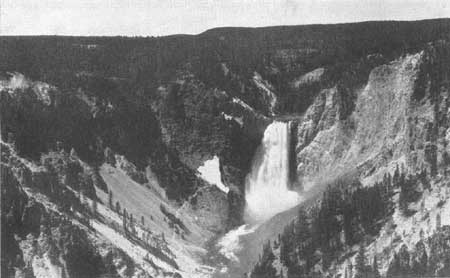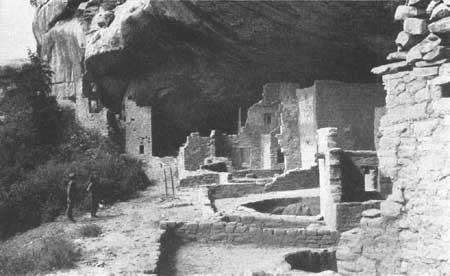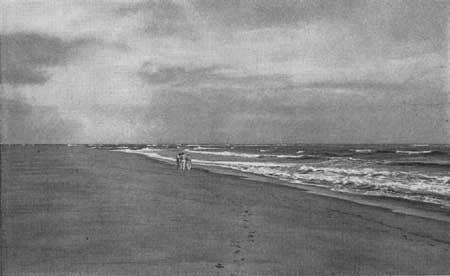.gif)
A Study of the Park and Recreation Problem of the United States
MENU
Aspects of Recreational Planning
Present Public Outdoor Recreational Facilities
A Park and Recreational Land Plan
|
A Study of the Park and Recreation Problem of the United States
|

|
Chapter VI: Legislation (continued)
FEDERAL LEGISLATION
Initial Federal legislation subsequent to the adoption of the Constitution recognizing parks and recreation as a national responsibility is found in an act of Congress approved June 30, 1864 (13 Stat. 325), granting to the State of California the "Yosemite Valley" and the "Mariposa Big Trees Grove" upon condition that the areas be held "for public use, resort, and recreation." This was followed by the Act of 1872 (17 Stat. 32) creating the Yellowstone National Park as a "public park or pleasuring ground for the benefit and enjoyment of the people." Subsequent acts similar in character have established additional national parks, battlefield sites, memorials, and parkways.

Figure 42.—Canyon of the Yellowstone River and Lower Falls,
Yellowstone National Park, Wyoming.
The Federal Antiquities Act was approved June 8, 1906 (34 Stat. 225) by which the "President of the United States is authorized in his discretion to declare by public proclamation, historic landmarks, historic and prehistoric structures, and other objects of historic or scientific interest that are situated upon the lands owned or controlled by the Government of the United States to be national monuments" and "when such objects are situated upon a tract covered by a bona fide unperfected claim or held in private ownership, the tract . . . may be relinquished to the Government and the Secretary of the Interior is hereby authorized to accept the relinquishment of such tracts in behalf of the Government of the United States." Under this authorization 82 national monuments have been established.
The National Park Service was created by an act approved August 25, 1916 (39 Stat. 535), "to promote and regulate the use of Federal areas known as national parks, monuments and reservations . . . by such means and measures as conform to the fundamental purpose of said parks, monuments, and reservations." Congress defined this purpose as being "to conserve the scenery and the natural and historic objects and the wildlife therein and to provide for the enjoyment of the same in such manner and by such means as will leave them unimpaired for the enjoyment of future generations."
An act of 1924 (43 Stat. 463), authorized and directed the National Capital Park and Planning Commission (as successor to the then existing National Capital Park Commission) to acquire such lands as were deemed "necessary and desirable" in the District of Columbia and adjacent areas in Maryland and Virginia "for the comprehensive, systematic, and continuous development of park, parkway, and playground systems of the National Capital and its environs." That Congress has viewed the development of the parks in and around Washington as of national rather than mere local benefit is reflected by the Act of 1890 (26 Stat. 492), which established Rock Creek Park "for the benefit and enjoyment of the people of the United States."
By Act of August 21, 1935 (49 Stat. 666), Congress declared it to be a national policy "to preserve for public use historic sites, buildings, and objects of national significance for the inspiration and benefit of the people of the United States" and empowered and directed the Secretary of the Interior through the National Park Service "to survey, investigate, acquire, restore, preserve, maintain, and operate historic and prehistoric sites, buildings, objects, and properties of national significance," and also provide for "cooperative agreements with States, municipal subdivisions, corporations, associations, or individuals to protect, preserve, maintain, or operate" such historic sites.
By Act of June 26, 1936 (49 Stat. 1982), Congress declared it to be the policy of the United States to assist in the construction where Federal interests are involved, but not the maintenance, of works for the improvement and protection of the beaches along the shores of the United States, and to prevent erosion due to the action of the waves, tides, and currents, with the purpose of preventing damage to property along the shores of the United States, and promoting and encouraging the healthful recreation of the people.
The Federal Government has recognized its interest and responsibility in the provision of recreational opportunities in local communities and in the several States as evidenced by legislation passed to meet certain situations. For instance, an Act of 1890 (26 Stat. 91), relating to the reservation and sale of town sites in Oklahoma, made it mandatory that all surveys for such town sites contain reservations for parks. The Act of October 5, 1914 (38 Stat. 727), authorized the Secretary of the Interior to withdraw from other disposition and reserve for county parks, public playgrounds and community centers for the use of the residents upon the lands, such tracts as he might deem advisable (not exceeding 20 acres in any township) in each reclamation project or the several units of such reclamation projects undertaken under the reclamation laws. An Act of June 14, 1926 (44 Stat. 741), authorizes the Secretary of the Interior to withhold from appropriation unreserved nonmineral lands which he has classified as chiefly valuable for recreational purposes and to sell, lease, or exchange to the States for park or recreational purposes in exchange for other lands.

Figure 43.—Spruce Tree House, Mesa Verde National Park, Colorado.
By an Act of July 10, 1930 (46 Stat. 1021), Congress enunciated the principle of conserving the natural beauty of shore lines for recreational use, and applied it specifically to all Federal lands which border upon any boundary, lake or stream contiguous to certain described areas situated in Minnesota or any other lake or stream which was then or eventually is to be in general use for boat or canoe travel, and for the purpose of carrying out this principle, generally prohibited logging of all such shores to a depth of 400 feet from the natural water line.
It is the general practice for Congress to authorize departments of the Federal Government by special act to convey to States and their civil divisions, lands, including improvements, for public park and recreational purposes. When such conveyances are made, it is stipulated that the States and local communities must assume the necessary obligations in carrying out the purposes of the grant. In case of nonperformance of the obligation within a certain period any property so conveyed reverts to the Federal Government.
Further recognition of the importance of recreation from a national viewpoint and the necessity for cooperative action between the Federal Government and the States and their civil divisions is reflected in the Act of June 23, 1936 (49 Stat. 1894) which authorized and directed the Secretary of the Interior, through the National Park Service, to make a study of park, parkway, and recreational-area programs, areas, and facilities and to cooperate with the States and their civil divisions in planning adequate and coordinated recreational systems.
It is apparent that the trend of Federal legislation is to broaden the responsibility of the Federal Government, not only in respect to the administration of areas and facilities directly under its supervision, but also in extending the recreational movement by cooperation with States and local communities in a Nation-wide program.

Figure 44.—On the beach, Cape Hatteras National Seashore Recreational
Area Project, North Carolina.
NEXT >>>
Last Modified: Mon, Aug 9 2004 10:00:00 pm PDT
http://www.cr.nps.gov/history/online_books/park_recreation/chap6a.htm
![]()
 Top
Top